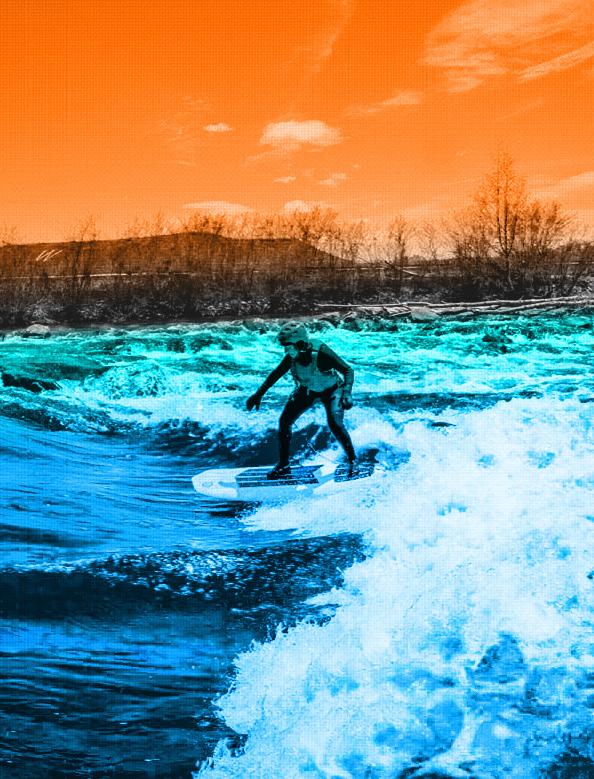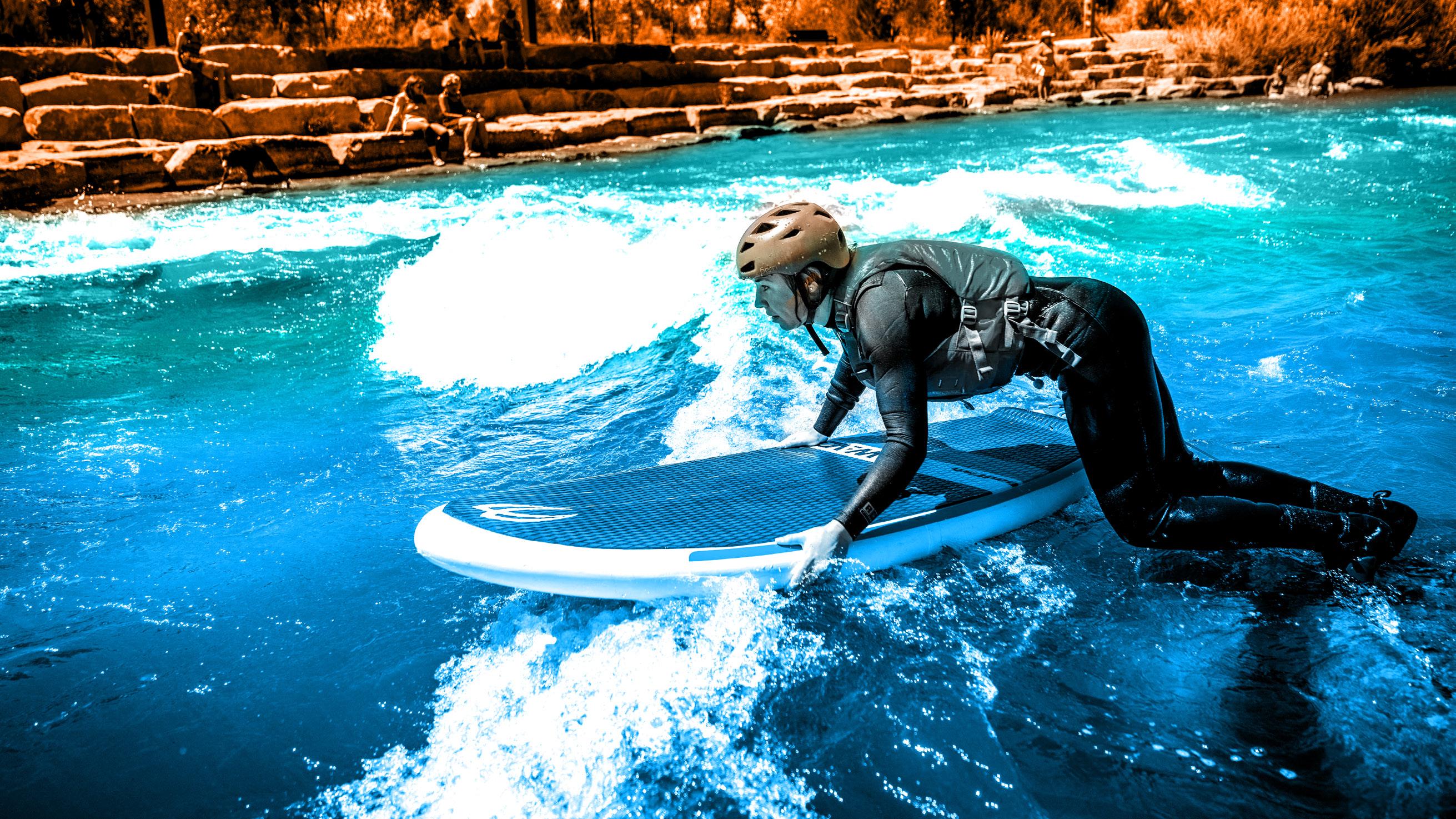
9 minute read
SURF'S UP IN COLORADO
SURF’S UP
IN COLORADO
Advertisement

A swell of new river surfers, whitewater parks, rental programs and manufacturers have accelerated this ocean sport in Colorado’s mountains
BY MORGAN TILTON
I planted my left bootie on the level rock beneath the loud, foamy water, preparing to launch myself into the curling wave. My river surfboard sat against my right hip, held between my hands and pointed up river. I took a deep breath before bending my knees and catapulting myself sideways into the wave, landing with my belly on the river surfboard — but I had too much momentum, slid past the sweet spot and was quickly washed away. The tame whitewater smacked my face as I made one easy swim stroke to catch the eddy, just below the queue of river surfers waiting for their next turn.
This was my first trip to river surf the Montrose Water Sports Park, and my sixth day surfing rivers. My ability to stand up on a board wasn’t sure-fire, and it took me four hours to catch the first wave. But I was amazed by the fact that I could endure that amount of river time here without feeling totally gassed or overcharged with adrenaline, thanks to the relatively calm water, moderate flow speed and easy exit following each wave. I only planted my feet above the wave once that day, and I’d absolutely be back for more sessions at this approachable whitewater park.
MONTROSE: THE HEART OF RIVER SURFING
The surge of river surfing on Colorado’s Western Slope has undoubtedly been driven by the Montrose whitewater community. Montrose Kayak and Surf (MKS) opened doors in conjunction with the Montrose Water Sports Park, a 1,000-foot long slice of the Uncompahgre River in the center of Riverbottom Park, surrounded by towering cottonwoods and emerald green grass, bridges, stone amphitheater seating and a paved path. The whitewater park debuted in 2015 with six wave features and ADAaccessible put-in and take-out ramps.
“River surfing is undeniably growing in interest — you only need to go to so many river surf spots to see,” said Mike Harvey, the co-founder of Badfish SUP, a global pioneer of whitewater stand-up paddleboards (SUPs) designed to surf river waves based in Salida, Colorado. “Montrose is a great example: the percentage of users in whitewater kayaks versus river surfing is overwhelmingly river surfing. The sport has grown and we expect it to grow. Twelve years ago we were the only ones doing it.”
The Montrose Water Sports Park waves are fed by sustained irrigation from April to October, an extensive season compared to other locations statewide. Every Wednesday night throughout the season, MKS hosts free demonstrations at the park, which is how shop manager Hollis Brake first started river surfing five years ago.
COLORADO: QUEEN OF WHITEWATER PARKS
When Montrose Kayak and Surf (MKS) opened, they didn’t know river surfing existed, Brake said. Then they met Harvey, who has influenced every aspect of river surfing’s evolution from board design and manufacturing to education, safety, retail and waves. He’s among a handful of U.S.based whitewater park and river-surf wave builders, a title he’s held since 1999, and still does part-time.
“River surfing was a heavily niche pursuit for a long time,” Harvey said. “In the last ten years, it’s become mainstream and Colorado is the epicenter, because we have more than

Eric Phillips river surfing at Montrose Water Sports Park. photo by Morgan Tilton 30 public whitewater parks — the highest volume in the world, there’s not even a close second place.”
Building a whitewater park is harder than one might imagine, mostly due to environmental regulations. After securing community support and funding, the structures need to comply with the Clean Water Act, which includes a two-prong approval process with state and federal agencies that can require up to two years.
The most attractive whitewater parks, like the Montrose Water Sports Park, are designed for recreationists of all abilities and skills.
“The most successful whitewater parks — with smooth, accessible waves — are achieved through the teamwork of engineers, public input and the tourism economy,” said David Riordon, president of the Colorado River Surfing Association. “Non-locals will travel to surf better whitewater parks.”
Colorado’s biggest engineering advancement is human-controlled waves, which have yet to be installed on the Western Slope, but Denver’s River Run Park has two. An underwater installation, dubbed the WaveShaper, features several adjustable plates that alter the wave shape. The result is a consistent surf experience despite variable streamflow conditions. The machine was invented by Denverite Rick McLaughlin, senior project manager at the Merrick & Company McLaughlin Whitewater Design Group. KEY TO COMMUNITY GROWTH: RIVER SURF EDUCATION
Brandon Slate, adventure specialist at Rocky Mountain Outdoor Center (RMOC) in Buena Vista, Colorado, has worked at RMOC for 11 years and leads the outfitter’s Learn to Surf program.
“My passion for surfing and wanting to share it with others sparked the Learn to Surf program, plus the fact that we have a variety of waves in the Arkansas River Valley,” Slate said.
Salida and Buena Vista each boast three popular waves at their whitewater parks, which are 25 miles apart. The season is stable from May to September, which can support a business plan with river surf lessons. At the time of publication, only two other organizations in the Centennial State offer river surf lessons: the Colorado River School and Chill Foundation.
Slate recalls that the first ever Learn to Surf clinics were taught at Buena Vista’s annual CKS Paddlefest in partnership with instructor Mike Tavares, six years ago. The professional whitewater stand-up paddleboarder rides for Badfish SUP. RMOC aptly added the curriculum to their offerings in 2016.
At first, river surfing entailed that a paddler stood upright with their feet planted on the stand-up paddleboard and a paddle in their hands: It was SUPing on a wave. Over the past few years, river surfing evolved to be done prone (on a person’s belly), emulating ocean surfers.
“It’s easier to teach prone river surfing, because crossing the eddy line and getting to the wave standing up is harder than it is when you’re paddling prone. Then you stand up when you get to the wave,” Slate said.
River surfboards have also evolved to support a prone technique.
“The boards are shorter, less thick and not as buoyant as they used to be,” Slate said. “They can hold a person up with speed, when there’s a wave, but a person can’t stand on them on flat water.”
The RMOC course has grown in popularity, especially among traveling ocean surfers.
“We’ll teach ocean surfers who have heard about river surfing, want to be safe and don’t understand river hydrology at all,” Slate said. “They’re seriously blown away that they’re facing upriver when they surf. Once we get on the wave, they’re teaching me how to surf, because they’re badass surfers.”
Beyond the classroom, the hordes of river surfers in the water each day has grown exponentially.
“You always have to wait in line at the token waves and even at the more challenging ones,” Slate said. “The upper wave in Salida was rebuilt to be more user-friendly and there’s easily 15 kids there at any given time. I like to see all these people surfing.”
RENTALS: TEST RIDE THE WATER
Last summer, the MKS river surfboard rentals were completely booked several days a week during the peak summer months.
“We saw so much more growth than what we anticipated that we were out of boards regularly,” Brake said. “The types of boards being rented also shifted to more performance-oriented boards, and more people started buying their own boards, too.”
This summer, MKS is expanding their rental fleet to 30 river surfboards, including 10 different designs from Badfish SUP, Hydrus Board Tech and Sol Paddle Boards. The surfboard rentals are available by reservation, and MKS is adding wetsuit rentals this summer as well.
Beyond MKS, only a handful of retailers offer river surfboard rentals across the state including Durango’s 4Corners Riversports, CKS Main Street in Buena Vista and Grand Junction's Stand Up Paddle.
RIVER SAFETY NEEDS TO STEP UP
One essential, yet lagging, trend is river surf safety. Releasable leashes, personal flotation devices (PFDs) and helmets are among the basic safety equipment. For some surfers, there’s a gap in education when they transition from ocean to river.
“Ocean surfers are reluctant to put on a releasable leash, because they’re used to wearing a non-releasable leash in the ocean — but rivers are a totally different environment,” Slate said. “Then, PFDs are not as comfortable when you’re lying prone. Helmets are commonly not used but river surfers could fall and hit their head on a rock, another person — especially if multiple people are surfing at once — or on a hardboard. Kayakers naturally put on a helmet, but many river surfers don’t have that background.”
To help, a life jacket rack — with free, first-come, first-served PFDs — was installed at the Buena Vista River Park and Salida’s Coors Boat Ramp last summer.
Riordon agrees that safety practices and education need to be developed by the river surf industry and in communities.
“Like the winter backcountry community, river surfing should develop free introductory training for river surfing and water safety,” Riordon said. “And like the Colorado Avalanche Information Center, we should publish the descriptions of individual waves, water flow levels and a daily surf report with hazard indicators.” HUGE POTENTIAL
“There are more arteries or veins inland than there are coastline miles. With development, more people can surf inland than in the ocean,” says CRSA Vice President Eric Thomas. Most of the plausible whitewater park locations in Colorado have been developed, but there remains a need to maintain and update wave designs to be river-surf friendly. And the vast opportunity to carve rivers statewide allows surfers to explore a variety of unique waves and waterways.
At 2,000 CFS (cubic feet per second), the Animas River’s Durango Whitewater Park surfing is world class, Harvey said — but if it gets too big or too low, the swimming is really challenging. The Gunnison River Whitewater Park is growing in popularity, he added.
One of the most alluring, exciting elements of river surfing is the discovery of a wave’s personality, how it shifts and comes alive with the water flow. The unpredictability and possibility of a wave’s arrival creates a sense of urgency around that wave’s fleeting existence. High flow days became synonymous with the uncontrollable desire and spontaneity of a skier’s powder day. And the energy of that shared experience connects river surfers in a simple, joyous way. No one noticed that day when I countlessly fell on the first wave at Montrose Water Sports Park. It was the process of learning and happiness I felt connecting with the water that mattered. The next time I surfed in Montrose, I caught every wave. Eventually, all surfers can find their flow.
The author catches a wave at Montrose Water Sports Park. photo by Eric Phillips MORGAN TILTON is an adventure journalist specializing in outdoor industry news and adventure travel. She grew up on Colorado’s Western Slope, where she commenced board sports on snow at her home mountain of Telluride Ski Resort, 18 years ago, inspiring her curiosity to eventually carve waves. Crested Butte, Colorado, is home.











